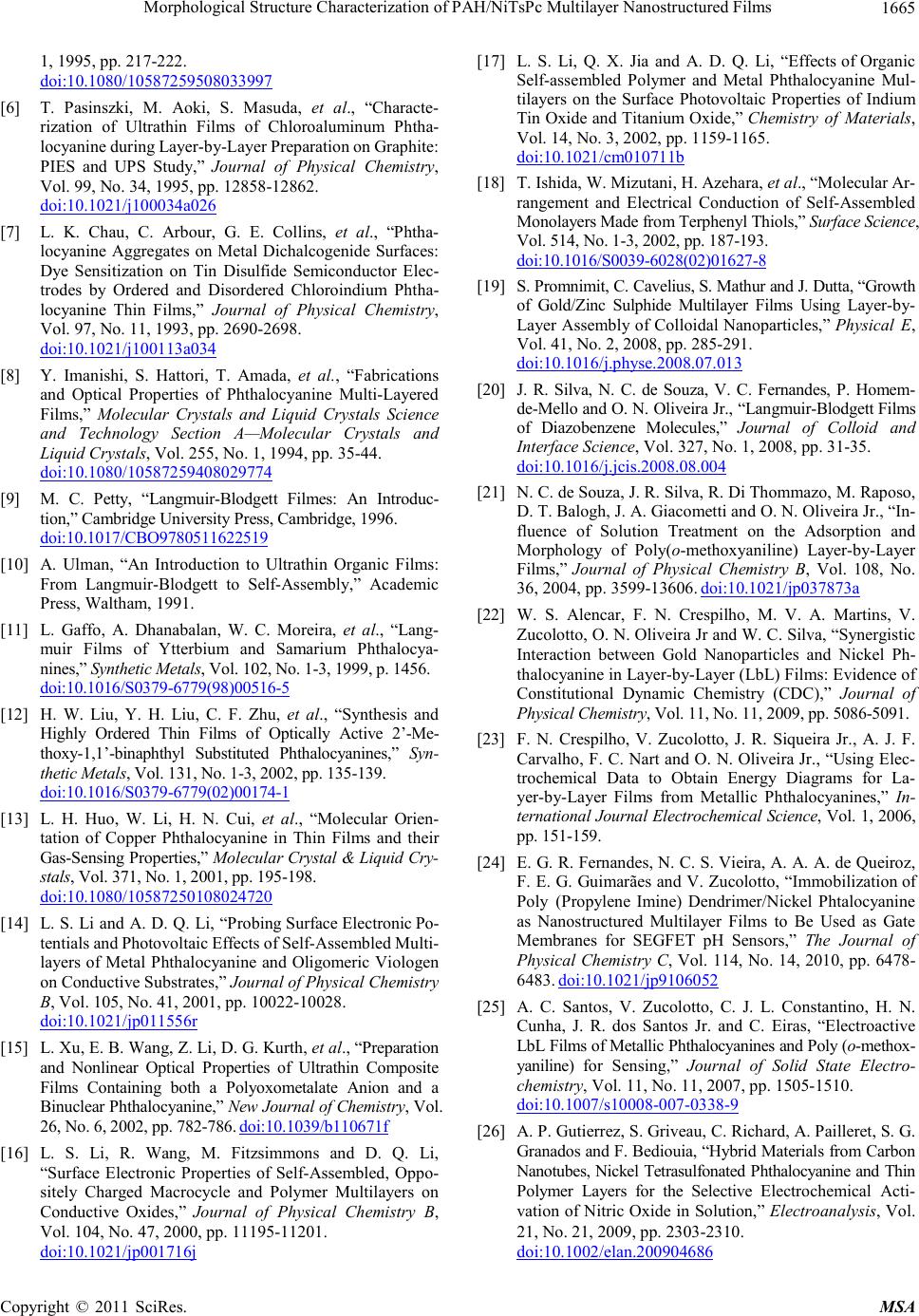
Morphological Structure Characterization of PAH/NiTsPc Multilayer Nanostructured Films1665
1, 1995, pp. 217-222.
doi:10.1080/10587259508033997
[6] T. Pasinszki, M. Aoki, S. Masuda, et al., “Characte-
rization of Ultrathin Films of Chloroaluminum Phtha-
locy anine during L ay er-by- Layer Prepa ration o n G raphite:
PIES and UPS Study,” Journal of Physical Chemistry,
Vol. 99, No. 34, 1995, pp. 12858-12862.
doi:10.1021/j100034a026
[7] L. K. Chau, C. Arbour, G. E. Collins, et al., “Phtha-
locyanine Aggregates on Metal Dichalcogenide Surfaces:
Dye Sensitization on Tin Disulfide Semiconductor Elec-
trodes by Ordered and Disordered Chloroindium Phtha-
locyanine Thin Films,” Journal of Physical Chemistry,
Vol. 97, No. 11, 1993, pp. 2690-2698.
doi:10.1021/j100113a034
[8] Y. Imanishi, S. Hattori, T. Amada, et al., “Fabrications
and Optical Properties of Phthalocyanine Multi-Layered
Films,” Molecular Crystals and Liquid Crystals Science
and Technology Section A—Molecular Crystals and
Liquid Crystals, Vol. 255, No. 1, 1994, pp. 35-44.
doi:10.1080/10587259408029774
[9] M. C. Petty, “Langmuir-Blodgett Filmes: An Introduc-
tion,” Cam br idg e Univ ers ity Pre ss, C ambridge, 1996.
doi:10.1017/CBO9780511622519
[10] A. Ulman, “An Introduction to Ultrathin Organic Films:
From Langmuir-Blodgett to Self-Assembly,” Academic
Press, Waltham, 1991.
[11] L. Gaffo, A. Dhanabalan, W. C. Moreira, et al., “Lang-
muir Films of Ytterbium and Samarium Phthalocya-
nines,” Sy nthe tic Metals, Vol. 102, N o. 1-3, 1 999, p. 1456.
doi:10.1016/S0379-6779(98)00516-5
[12] H. W. Liu, Y. H. Liu, C. F. Zhu, et al., “Synthesis and
Highly Ordered Thin Films of Optically Active 2’-Me-
thoxy-1,1’-binaphthyl Substituted Phthalocyanines,” Syn-
thetic Metals , Vol. 13 1, N o. 1- 3, 2002, pp. 135- 1 39.
doi:10.1016/S0379-6779(02)00174-1
[13] L. H. Huo, W. Li, H. N. Cui, et al., “Molecular Orien-
tation of Copper Phthalocyanine in Thin Films and their
Gas-Sensing Properties,” Molecu lar Crysta l & Liqui d Cry-
stals, Vol. 371, No. 1, 20 01, pp. 195-19 8.
doi:10.1080/10587250108024720
[14] L. S. Li an d A. D. Q. Li, “P robing Surface Electronic Po-
tentia ls a nd Pho to volt aic Ef f ec ts of Se lf -Assem ble d Multi -
layers of Metal Phthalocyanine and Oligomeric Viologen
on Cond uc tiv e Substr a te s ,” Journal of Physical Chemistry
B, Vol. 105, No. 41, 2001, pp. 10022-10028.
doi:10.1021/jp011556r
[15] L. Xu, E. B. Wang, Z. Li, D. G. Kurth, et al., “Preparation
and Nonlinear Optical Properties of Ultrathin Composite
Films Containing both a Polyoxometalate Anion and a
Binuclear Phthalocyanine,” New Journal of Chemistry, Vol.
26, No. 6, 200 2, p p. 78 2- 78 6. doi:10.1039/b110671f
[16] L. S. Li, R. Wang, M. Fitzsimmons and D. Q. Li,
“Surface Electronic Properties of Self-Assembled, Oppo-
sitely Charged Macrocycle and Polymer Multilayers on
Conductive Oxides,” Journal of Physical Chemistry B,
Vol. 104, No. 47, 2000, pp. 11195-11201.
doi:10.1021/jp001716j
[17] L. S. Li, Q. X. Jia and A. D. Q. Li, “Effects of Organic
Self-assembled Polymer and Metal Phthalocyanine Mul-
tilayers on the Surface Photovoltaic Properties of Indium
Tin Oxide and Titanium Oxide,” Chemistry of Materials,
Vol. 14, No. 3, 2002, pp. 1159-1165.
doi:10.1021/cm010711b
[18] T. Ishida, W. Mizutani, H. Azehara, et al., “Molecular Ar-
rangement and Electrical Conduction of Self-Assembled
Monolay er s Ma de f rom Te rphe ny l T hiols ,” Sur fac e Sc ie nce ,
Vol. 514, No. 1-3, 2002, pp. 187- 193.
doi:10.1016/S0039-6028(02)01627-8
[19] S. Promnimit, C. Cavelius, S. Mathur and J. Dutta, “Growth
of Gold/Zinc Sulphide Multilayer Films Using Layer-by-
Layer Assembly of Colloidal Nanoparticles,” Physical E,
Vol. 41, No. 2, 2008, pp. 285-291.
doi:10.1016/j.physe.2008.07.013
[20] J. R. Silva, N. C. de Souza, V. C. Fernandes, P. Homem-
de-Mello and O. N. Oliveira Jr., “Langmuir-Blodgett Films
of Diazobenzene Molecules,” Journal of Colloid and
Interface Science, Vol. 327, No. 1, 2008, pp. 31-35.
doi:10.1016/j.jcis.2008.08.004
[21] N. C. de Souza, J. R. Silva, R. Di Thommazo, M. Raposo,
D. T. Balogh, J. A. Giacometti and O. N. Oliveira Jr., “In-
fluence of Solution Treatment on the Adsorption and
Morphology of Poly(o-methoxyaniline) Layer-by-Layer
Films,” Journal of Physical Chemistry B, Vol. 108, No.
36, 2004 , pp. 3 5 99-13606. doi:10.1021/jp037873a
[22] W. S. Alencar, F. N. Crespilho, M. V. A. Martins, V.
Zucolotto, O. N. Oliveira Jr and W. C. Silva, “Synergistic
Interaction between Gold Nanoparticles and Nickel Ph-
thalocyanine in Layer-by-Layer (LbL) Films: Evidence of
Constitutional Dynamic Chemistry (CDC),” Journal of
Physical Chemistry, Vol. 11, No. 11, 2009, pp. 5 086-5091.
[23] F. N. Crespilho, V. Zucolotto, J. R. Siqueira Jr., A. J. F.
Carvalho, F. C. Nart and O. N. Oliveira Jr., “Using Elec-
trochemical Data to Obtain Energy Diagrams for La-
yer-by-Layer Films from Metallic Phthalocyanines,” In-
ternational Journal Electrochemical Science, Vol. 1, 2006,
pp. 151-15 9.
[24] E. G. R. Fernandes, N. C. S. Vieira, A. A. A. de Queiroz,
F. E. G. Guimarães and V. Zucolotto, “Immobilization of
Poly (Propylene Imine) Dendrimer/Nickel Phtalocyanine
as Nanostructured Multilayer Films to Be Used as Gate
Membranes for SEGFET pH Sensors,” The Journal of
Physical Chemistry C, Vol. 114, No. 14, 2010, pp. 6478-
6483. doi:10.1021/jp9106052
[25] A. C. Santos, V. Zucolotto, C. J. L. Constantino, H. N.
Cunha, J. R. dos Santos Jr. and C. Eiras, “Electroactive
LbL Films of Metallic Phthalocyanines and Poly (o-methox-
yaniline) for Sensing,” Journal of Solid State Electro-
chemistry, V ol. 11, No. 11, 2007, pp. 1505-1510.
do i:10.1007/s10008-007-0338-9
[26] A. P. Gutierrez, S. Griveau, C. Richard, A. Pailleret, S. G.
Granados and F. Bediouia, “Hybrid Materials from Carbon
Nanotubes, Nickel Tetrasulfonated Phthalocyanine and Thin
Polymer Layers for the Selective Electrochemical Acti-
vation of Nitric Oxide in Solution,” Electroanalysis, Vol.
21, No. 21, 2009, pp. 2303-2310.
doi:10.1002/elan.200904686
Copyright © 2011 SciRes. MSA